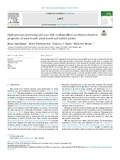High-pressure processing and sous-vide cooking effects on physicochemical properties of meat-based, plant-based and hybrid patties
Fecha
2023Autor
Versión
Acceso abierto / Sarbide irekia
Tipo
Artículo / Artikulua
Versión
Versión publicada / Argitaratu den bertsioa
Impacto
|
|
10.1016/j.lwt.2022.114273
Resumen
Modern technologies such as high-hydrostatic pressure processing (HPP) and sous-vide cooking (SVCOOK) have
not been fully assessed for improving the quality of veal patties. The effects of HPP alone or combined with
SVCOOK technique on physicochemical characteristics of veal, plant-based, and hybrid patties were investigated.
Samples of the different formulations were subjected to three pressu ...
[++]
Modern technologies such as high-hydrostatic pressure processing (HPP) and sous-vide cooking (SVCOOK) have
not been fully assessed for improving the quality of veal patties. The effects of HPP alone or combined with
SVCOOK technique on physicochemical characteristics of veal, plant-based, and hybrid patties were investigated.
Samples of the different formulations were subjected to three pressures (350–600 MPa) for 5–15 min, followed
by SVCOOK (55–65 ◦C for 15 min). The color of the HPP treated plant-based and hybrid patties tended to be of
less reddish color tone and conformed more towards a yellowish shade. The dual technology treated hybrid
patties were like veal patties in color and texture parameters, whereas the physicochemical parameters of plantbased patties were different from veal and hybrid patties. Conversely, the effect of HPP on hybrid patties was not
comparable to veal patties. The dual (HPP–SVCOOK) technology has the potential to develop novel hybrid
products with physicochemical characteristics comparable to those of veal-based patties. [--]
Materias
High-pressure processing,
Vacuum-cooking,
Veal,
Legume,
Meat analogue
Editor
Elsevier
Publicado en
LWT-Food Science and Tecnology 173 (2023) 114273
Departamento
Universidad Pública de Navarra/Nafarroako Unibertsitate Publikoa. Institute on Innovation and Sustainable Development in Food Chain - ISFOOD
Versión del editor
Entidades Financiadoras
This project has received funding from the European Union's H2020 research and innovation program under the Marie Sklodowska-Curie grant (grant agreement No 801586)







